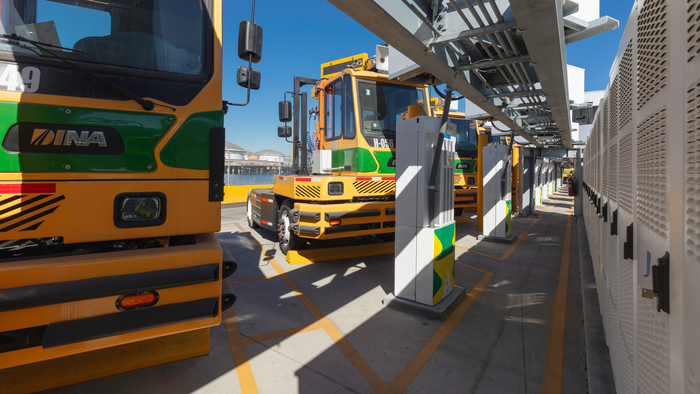Port of Long Beach unveils fleet of 33 battery-powered yard tractors
Vehicles recharge through automated, mechanized connectors as 20% of port’s equipment is now zero-emissions

The Port of Long Beach on Thursday unveiled a fleet of 33 human-operated, zero-emissions, battery-electric yard tractors at a container terminal where the cargo-handling machines have replaced traditional gasoline and diesel-powered models.
The deployment – which the port called the largest of its kind on the West Coast – was led by terminal operator SSA Terminals LLC, a joint venture between SSA Marine and Matson Navigation Company. It is partially funded by a $50 million grant from the California Air Resources Board (CARB) for the Sustainable Terminals Accelerating Regional Transformation (START) project and Near Zero Emission Freight Facility (ZANZEFF) program.
The new machines increase the percentage of zero-emissions equipment being used at the Port of Long Beach to approximately 20%, accelerating Pier C’s progress toward zero-emissions operations. That process that will continue further as SSA Terminals works to integrate zero-emissions, human-driven, top handlers.
The facility features an automated charging system that uses mechanized electrical connectors known as high-power Quick Charging Connector (QCC) systems. Those are provided by Stäubli Electrical Connectors through an agreement with SSA. According to Switzerland-based Stäubli, the project is one of the biggest mechanized charging programs for electric vehicles at active ports in the United States. SSA Terminals and Stäubli are also currently implementing five additional units with QCCs at the Port of Oakland.
Stäubli says its 33 QCC systems automatically connect the site’s 175kW DC chargers to an electric receptacle on each terminal tractor through zero-touch operation. That approach enables all 33 tractors to be charged simultaneously with no manual intervention. Operators simply pull into a charging station and the QCC deploys to plug in the tractors during breaks or shift changes for maximum charging uptime, and labor utilization, the company said.
Related Articles
Copyright ©2024. All Rights ReservedDesign, CMS, Hosting & Web Development :: ePublishing